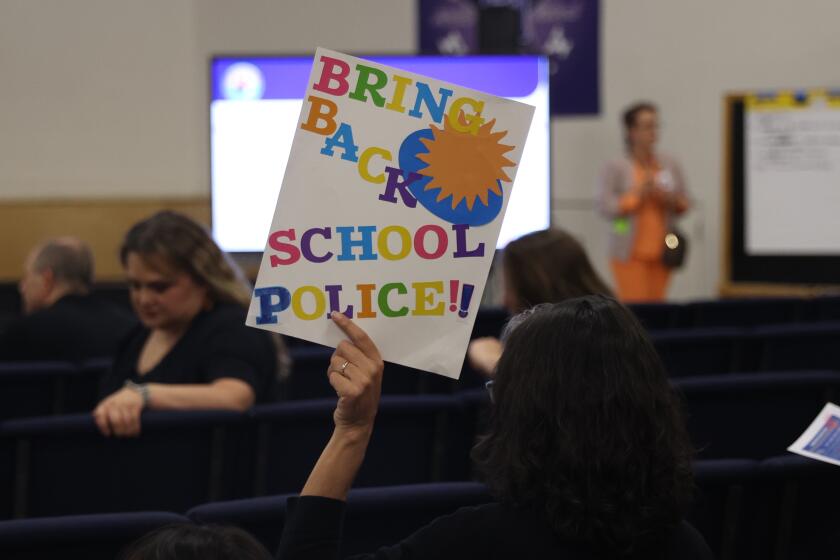Teachers’ Guide
Jodi Manby faces a baffling task in her classroom at Kelso Elementary School.
With virtually no experience, the rookie teacher must find a way to unlock the mystery of words for her fidgety second-graders.
Some days, Manby feels lost.
That is when she calls on her reading coach, a veteran colleague at the Inglewood school who critiques lessons and offers advice.
“It’s important for a first-year teacher to have a safety net,” Manby says.
That net is being cast across hundreds of classrooms statewide--all beneficiaries of a new private initiative to reshape reading instruction in the primary grades.
Armed with grants from the David and Lucile Packard Foundation, 27 school districts have created networks of reading coaches to help instructors in kindergarten through third grade teach the Open Court reading program, which combines intensive phonics and literature with daily guidelines on what to teach and for how long.
The foundation spent $5 million last year and is spending $15 million this year to staff more than 200 schools with coaches--experienced teachers who are freed from their regular duties to assist in classrooms.
Underlying the initiative is the recognition that reading reform must involve changes not only in books and philosophy but instruction itself.
“Our interest is on what the teacher is doing in the classroom while teaching reading,” said David W. Packard, a former UCLA professor and son of the co-founder of the foundation and Hewlett-Packard. “Teaching people to read is almost an engineering task. It ought to be possible to design a program to see what works.”
Few details are left to chance in the initiative, known as the Reading Lions Project.
To qualify for a grant, school districts must already be using Open Court in their elementary schools.
Districts must agree to use the program in all classrooms for at least one a hour a day in kindergarten and two hours in grades one through three. Teachers, coaches, principals and district officials attend training sessions.
The foundation provides supplemental materials, including 2 million booklets it had printed this year to reinforce phonics lessons--enough to allow more than 54,000 students to each take 20 books home.
Project officials believe that the cohesion will produce results. And accordingly, they have set high expectations.
At the end of three years, 85% to 90% of third-graders at the schools are expected to read at or above grade level--the 50th percentile on the state’s standardized test, the Stanford 9.
That goal is lofty, given the poor performance of California’s schoolchildren on such tests. Just 38% of third-graders reached the 50th percentile on last spring’s Stanford 9.
Officials say it is too soon to evaluate the effectiveness of the program, now in its second year. But they say preliminary findings are encouraging.
In the Fremont Unified School District, scores rose for first- and second-graders on the Iowa Test of Basic Skills one year after the reading coaches and Open Court were introduced, district officials report.
The number of first-graders scoring at or above the 50th percentile in reading jumped from 63% to 75% between 1997 and 1998. The portion of second-graders reaching the same level rose from 55% to 65%.
“To show that kind of growth in the first year looks very promising,” said Bev Shaw, coordinator of assessment and instructional materials for the Fremont district, near San Jose. “We have to see if it’s a trend or a one-year thing. Our hope and expectation is that our test scores will continue to rise.”
*
Educators in other districts say that the Packard initiative is valuable because it organizes instruction while providing support for teachers who are struggling.
At Kelso Elementary, reading coach Shelly Brower has become a fixture in the classrooms of inexperienced teachers.
Brower spent a recent morning observing Manby, the new second-grade instructor.
Brower stood in the back of the classroom scribbling notes as Manby reviewed vocabulary with her students.
After class, Manby met Brower for an informal conference.
Brower praised Manby’s lesson on vocabulary development, and said the new teacher did a good job of keeping the students on task.
Then she gave Manby gentle advice: Clearly point out prefixes and suffixes in words so that children understand them.
“Every time we meet I feel like I get a little bit better,” Manby said, adding, “If I come across a lesson and have no idea where to go with it, Shelly will come in and demonstrate.”
Kelso has been using Open Court for more than a decade, producing scores that exceed state averages.
Even so, the school--like other Packard campuses--regularly tests its primary grade students to see if they are understanding the lessons. The results are used to modify instruction.
Although the effort has been embraced by the 27 districts, it has met resistance among some veteran teachers who object to the heavily scripted Open Court program.
“If someone told me I had to give up everything I had created, it would be hard,” one program official conceded.
But educators say the oversight and program’s structure work for many teachers who need assistance. And Packard said he expects the project to continue for five to 10 years.
“This is not a one- or two-year effort,” Packard said. “We need to follow these kids to learn from what we are doing.”
More to Read
Start your day right
Sign up for Essential California for news, features and recommendations from the L.A. Times and beyond in your inbox six days a week.
You may occasionally receive promotional content from the Los Angeles Times.






